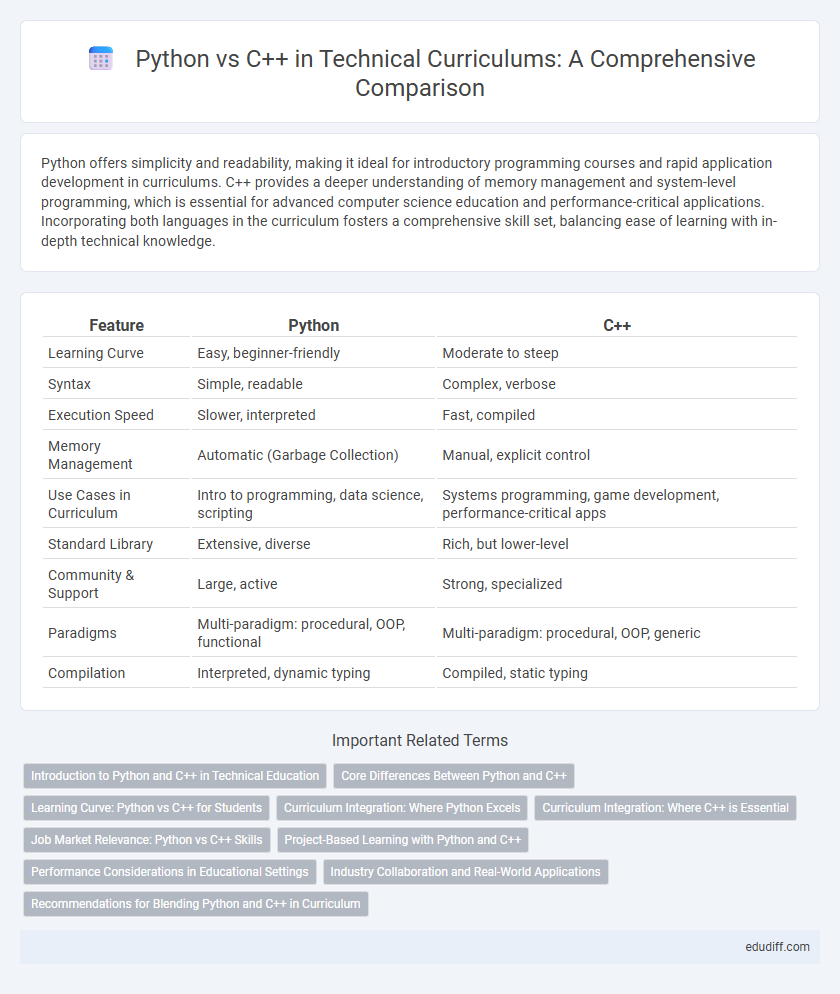Python offers simplicity and readability, making it ideal for introductory programming courses and rapid application development in curriculums. C++ provides a deeper understanding of memory management and system-level programming, which is essential for advanced computer science education and performance-critical applications. Incorporating both languages in the curriculum fosters a comprehensive skill set, balancing ease of learning with in-depth technical knowledge.
Table of Comparison
| Feature | Python | C++ |
|---|---|---|
| Learning Curve | Easy, beginner-friendly | Moderate to steep |
| Syntax | Simple, readable | Complex, verbose |
| Execution Speed | Slower, interpreted | Fast, compiled |
| Memory Management | Automatic (Garbage Collection) | Manual, explicit control |
| Use Cases in Curriculum | Intro to programming, data science, scripting | Systems programming, game development, performance-critical apps |
| Standard Library | Extensive, diverse | Rich, but lower-level |
| Community & Support | Large, active | Strong, specialized |
| Paradigms | Multi-paradigm: procedural, OOP, functional | Multi-paradigm: procedural, OOP, generic |
| Compilation | Interpreted, dynamic typing | Compiled, static typing |
Introduction to Python and C++ in Technical Education
Python's simple syntax and readability make it an ideal choice for introducing programming concepts in technical education, facilitating faster learning curves for beginners. C++ offers a deeper understanding of memory management and system-level operations, providing foundational skills essential for performance-critical applications. Integrating both languages in the curriculum equips students with versatile coding competencies and prepares them for diverse technical challenges.
Core Differences Between Python and C++
Python emphasizes simplicity with dynamically typed syntax and automatic memory management, making it ideal for rapid development and scripting. C++ offers statically typed syntax, explicit memory control, and low-level system access, providing high performance and fine-grained optimization capabilities. Core differences include Python's interpreted nature versus C++'s compiled model, impacting execution speed and application use cases in software engineering education.
Learning Curve: Python vs C++ for Students
Python offers a gentler learning curve for students due to its simple syntax and dynamic typing, allowing beginners to grasp programming concepts faster. In contrast, C++ introduces complex topics like manual memory management and strict type declarations, which can be challenging for novices. Educators often recommend Python for initial courses to build confidence before transitioning to the more demanding, performance-oriented C++ curriculum.
Curriculum Integration: Where Python Excels
Python excels in curriculum integration due to its simplicity, readability, and extensive libraries, enabling seamless adoption across diverse subjects such as data science, machine learning, and web development. Its interpreted nature allows immediate feedback, enhancing student engagement and iterative learning compared to C++'s complex syntax and compile-time errors. Educational institutions prioritize Python for foundational programming courses to build strong problem-solving skills before advancing to lower-level languages like C++.
Curriculum Integration: Where C++ is Essential
C++ is essential in curricula focused on systems programming, game development, and real-time applications due to its low-level memory manipulation and high performance capabilities. It integrates seamlessly with courses on computer architecture, operating systems, and embedded systems, providing a practical foundation for understanding hardware-software interaction. Python, while versatile, lacks the fine-grained control required in these areas, making C++ irreplaceable for specialized technical training.
Job Market Relevance: Python vs C++ Skills
Python dominates job market relevance due to its versatility in data science, machine learning, and web development, making Python skills highly sought after by employers. C++ remains essential for roles in systems programming, game development, and performance-critical applications, offering strong demand in specialized sectors. Mastery of Python enhances employability in emerging tech fields, while proficiency in C++ proves valuable for legacy systems and performance-intensive industries.
Project-Based Learning with Python and C++
Project-based learning using Python enhances curriculum engagement through its simple syntax and extensive libraries, enabling rapid prototyping and real-world application development. C++ offers deeper understanding of memory management and system-level programming, which is essential for high-performance computing projects and embedded systems. Combining Python for initial concept development and C++ for optimization allows students to gain comprehensive programming skills suited for diverse technical challenges.
Performance Considerations in Educational Settings
Python offers simplicity and rapid prototyping, making it ideal for foundational programming courses, while C++ provides superior execution speed and fine-grained memory control essential for advanced systems programming education. Educators must weigh Python's ease of learning against C++'s performance benefits to align curricula with course objectives and student skill levels. Integrating C++ in later stages enables in-depth exploration of optimization and hardware-level programming critical for high-performance applications.
Industry Collaboration and Real-World Applications
Python's widespread adoption in industry collaboration projects stems from its simplicity and extensive libraries, enabling rapid prototyping and integration with real-world applications in AI, data science, and automation. C++ remains essential for performance-critical applications in game development, embedded systems, and high-frequency trading, where low-level memory management and execution speed are paramount. Curricula incorporating both languages address diverse industry needs by emphasizing Python's versatility and C++'s efficiency, fostering graduates proficient in collaborative real-world problem-solving.
Recommendations for Blending Python and C++ in Curriculum
Integrating Python and C++ in a programming curriculum leverages Python's simplicity for teaching foundational concepts while utilizing C++ for performance-critical applications and systems programming. Blending these languages enhances students' versatility by allowing early exposure to high-level abstractions alongside low-level memory management and optimization techniques. Curriculum design should incorporate project-based learning that transitions from Python scripting to C++ development to build comprehensive programming skills applicable across diverse computational problems.
Python vs C++ in Curriculum Infographic

 edudiff.com
edudiff.com